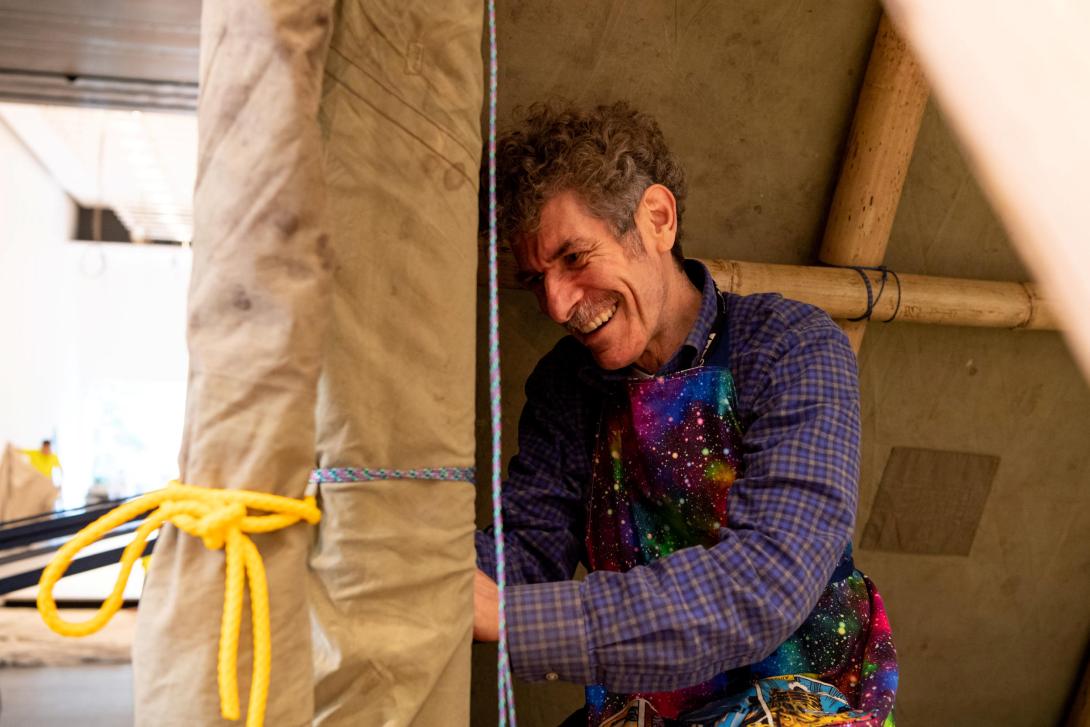Michael Marendy | Conservator, Textiles
By The Last Word
Artlines | 1-2023 | March 2023
| Editor: Stephanie Kennard
Every Artlines issue, we invite an artist, curator or friend of the Gallery to share their practice and passions with us. Here, Artlines spoke with textile conservator Dr Michael Marendy, whose esteemed career has encompassed design, education, conservation and curatorship.
Explain the essence of your practice in 50 words or less.
My practice spans four distinct areas: clothing design, fashion education, textile conservation and museum curatorship. To cross these overlapping professional areas, I studied in Australia, Canada and England. (My PhD, from Griffith University, focused on stories of women involved in the custom-made clothing trade in colonial Brisbane, and the rationale for their collection in museums.) After I graduated from the textile program at the University of Alberta in Canada in 1988, and with the additional skills I’d acquired in textile conservation, I established a conservation practice in Brisbane in 1990 and have since worked for private clients, small regional museums and state institutions.
Day to day, what might your work involve?
To preserve a textile and make it safe for display, I may wet or dry clean the textile, and then stabilise it using couching stitches and fabrics such as silk crepeline, silk organza, cotton batiste or polyester tulle. Displaying two-dimensional textiles sometimes require the addition of a casing, a Velcro header or even a full lining. Costumes, on the other hand, require appropriately sized mannequins, which may also need padding. In some cases, soft mannequins (which do not have heads, arms, legs or stands) need to be custom-made for the costumes to be displayed.

Dr Michael Marendy, working on an APT10 installation, GOMA, November 2021 / Photograph: C Callistemon, QAGOMA
How has your practice changed over time?
For 15 years, I taught clothing design and textile science at TAFE and in universities, but in 1998, I re-established my textile conservation practice on a full-time basis, and undertook projects such as auditing and repacking the Queensland Museum’s costume and textile collection (in 2006). In 2008–09, I was the consulting curator and conservator for the Museum of Brisbane’s exhibition ‘In Fashion: Dressing up Brisbane’. In 2012, I curated and conserved the garments featured in the Queensland Museum’s first costume exhibition, ‘Dressed by the Best: Fashion, Glamour and Gwen Gillam’. For QAGOMA, I’ve worked as the consulting textile conservator on QAG exhibitions including ‘Ruth Stoneley: A Stitch in Time’, ‘Quilts 1700–1945’ and ‘Hats: An Anthology by Stephen Jones’ (with the Victoria and Albert Museum, London); and GOMA exhibitions such as ‘Marvel: Creating the Cinematic Universe’; ‘Future Beauty: Thirty Years of Japanese Fashion’; ‘Valentino, Retrospective: Past/Present/Future’ and ‘Threads: Contemporary Textiles and the Social Fabric’. In addition to these roles, I have given numerous lectures on conservation and dress history, as well as conducting conservation workshops throughout Queensland and northern New South Wales. In 2022, QAGOMA appointed me as its permanent textile conservator.
What memorable responses have you had to your work?
Last year, the Queensland Women’s Historical Association nominated me for an award: the Australian Institute for the Conservation of Cultural Materials (AICCM) ‘Conservator of the Year’. I was very pleased to learn that the AICCM agreed with them and gladly accepted the award.
What work do you most enjoy doing?
I am always very animated when I work on contemporary haute couture or period costumes, and I enjoy being able to discuss their conservation treatment and display techniques with the public.
What research do you do?
Research is always necessary for my work. It can be related to a weaving or dyeing technique, or to the cut of a particular garment. Fibres may need to be identified. If the costume or textile is to be displayed, it also needs to be dated accurately; in the case of a costume, even the style of undergarments worn at the time may need to be reproduced to provide the correct silhouette. When something difficult confronts me, such as the removal of an unusual stain, I rely heavily on the conservation literature.
What are you working on now?
I am currently preparing 12 ikat textiles for the 2023 QAGOMA exhibition ‘I can spin skies’, which opens in August [2023].
Name something people might be surprised to learn about you.
I bake bread every fortnight! My favourites include Black Olive, Red Onion and Mint, Oregano and Olive Oil, Raisin and Orange, and Wholemeal Spelt.

Amanda Slack-Smith (Curatorial Manager, Australian Cinémathèque) and Dr Michael Marendy, presenting at ‘Behind the Seams’ for ‘Fairy Tales’, GOMA, February 2024 / Photograph: J Ruckli, QAGOMA
